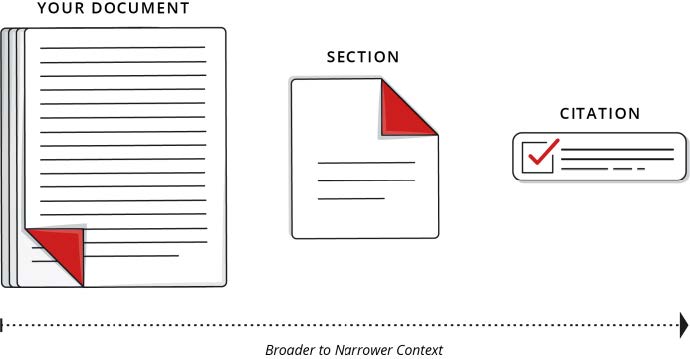The first thing you need to do is to place your term into the proper context. If you are in a discussion and need to define your term, you’ll be thinking about the discussion you are having, and what types of concepts are being bandied about. If you are writing a document, you’ll probably need to narrow the concept down to one. We’ll stick with you writing a definition for a document, and we’ll use the term pattern-hiding display.
The document you are working with will form the subject field for the broadest context you are going to work with. The citation, no doubt, falls within a section of that document. And sections are broken down into various contexts within the document. Within that section, the Citation will provide the most specific context you are dealing with.

Now let’s look at the phrase pattern-hiding display within the context of the document, the Section, and the Citation it was found in.
What | Context |
Information Security Policy | Protecting Information |
Section 3.1 | Using Access Controls |
3.1.10 | pattern-hiding displays protect information by preventing viewing of data |
From this, we know that the context is about hiding information from view is a form of access control that protects information. Got it. We know from our document that pattern-hiding displays are covered in the section on access controls. So we are pretty certain that the general category for our term is going to be access control. But on looking up the definition for access control, we found that it can cover physical access, computer system access, and information access as well. So we have several subcategories of access control that exist.
So let’s start a worksheet for adding the term, the term’s possible category, and any possible subcategories that we know of. Then we’ll see if they fit.
Term | Category | Subcategory | Fit? |
| pattern-hiding display | access control | physical assets | N |
| computer system | N | ||
| information | Y |
In our context, neither computer system nor physical assets fit our genus. Therefore, we know that the context we have we are dealing with an information access control. But what type? That’s found in the attributes.
Now that you have the general category for the concept, you must examine the language for its attributes. When we talk about attributes in this document, we specifically mean the distinguishing features as derived from the words used and the context in which they are used.
Because you are going to be dealing with terms you’ve found in a Citation, the attributes are really the individual terms you are dealing with within the context of the document you are working with. If you have two words in a phrase, you have two attributes. In our scenario we have two words; pattern-hiding and display. Our attributes for this term are threefold:

We now need to search for each term in the various dictionaries and check to see if there are any definitions that fit our context of information access control that we are dealing with.
Searching dictionaries for either pattern-hiding or pattern hiding produces nothing on its own. Searching the web for either one produces some rough definitions of algorithms and software methodologies to obscure numbers or images on a screen.
Term | Category | Subcategory | Fit? |
| pattern-hiding | session lock | Concealing information previously visible on a display. | Y |
| prime number | Artificial numeric patterns that are embedded with previously thought to be random numbers. | N | |
| screen saver lock | The capability, when the computer is locked, to set the screen to black or display selected or random images or numbers. | Y |
Searching for display gives us a bunch of definitions. One of which is a computer monitor, another of which is the process or facility of presenting data or images on a computer screen or other device. Within the context of the Citation and its section, we can conclude that the characteristic isn’t about the monitor per se, but about the ability to display data or images.
Term | Category | Subcategory | Fit? |
| display | art | A performance or show. | N |
| assets | An electronic device for the visual presentation of data. | N | |
| computing | Process or facility of presenting data or images on a computer screen or other device. | Y |
We now have a comprehensive view of what our concept is and one step closer to writing a good definition.
Term | Category | Subcategory | Attribute |
| pattern-hiding display | access control | information | |
| pattern-hiding | session lock | Concealing information previously visible on a display. | |
| screen saver lock | The capability, when the computer is locked, to set the screen to black or display selected or random images or numbers. | ||
| display | computing | Process or facility of presenting data or images on a computer screen or other device. |